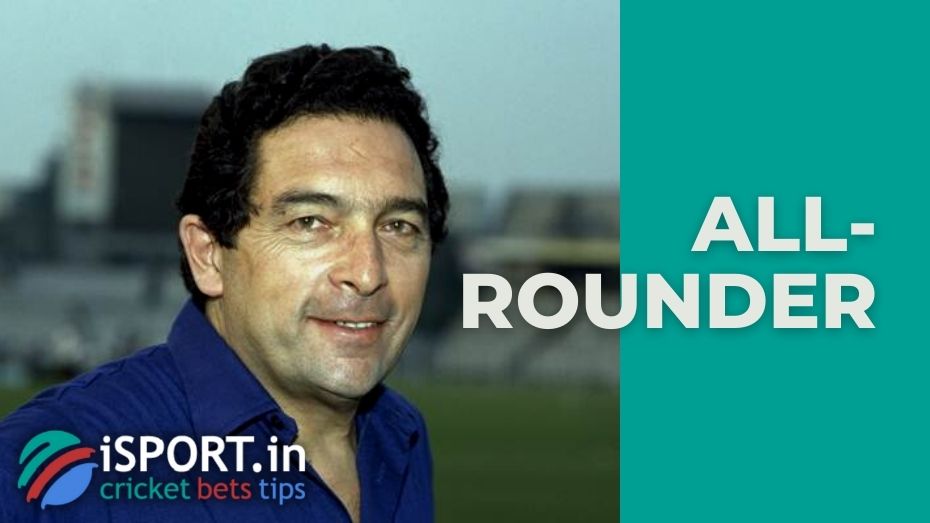All-rounder

In cricket, players typically specialize in specific roles — bowler, batsman, or wicket-keeper. However, if a player excels at both batting and bowling, they are referred to as an all rounder.
All rounder: The Basic Meaning
As in football, cricketers can play in different positions in training. However, in official matches, players strive to perform in the roles where they feel most confident. On our website, when discussing the biographies of famous players, we usually categorize them as bowlers, batsmen, or wicket-keepers.
Theoretically, the term all rounder can be applied to a player who is both a skilled wicket-keeper and a reliable batsman. However, more often, the expression “wicketkeeper-batsman” is applied to such players.
In both cases, the use of terms is subjective. There are two versions:
- Experts and fans generally consider a player an all-rounder if their skills are strong enough to earn a place in the starting eleven in both roles.
- A less common definition suggests that a player qualifies as an all-rounder if they can contribute significantly in two different positions.
Regardless of the definition, one thing is universally agreed upon in the cricketing world: all-rounders provide undeniable value to their teams.
All-rounder: Who Becomes One?
There were vivid examples of strong bowlers at the end of the last century who could be called all rounders.
Historically, there have been many examples of bowlers who also demonstrated strong batting abilities. In the late 20th century, West Indies bowler Malcolm Marshall was often described as a “useful lower-order batsman” or “a bowler who bats a bit,” as he averaged under 19 runs per match. However, he had an impressive streak — scoring over 10 runs in 107 consecutive innings.
Among the batsman in the 80s of the 20th century, Allan Border from Australia stood out. At the same time, he took 11 runs from 96 runs in the match of the Australian national team against the West Indies. Border made good use of a left-handed spin throw against an opponent.
In cricket, particularly in the women’s game, true all rounder is relatively rare because players tend to peak in their respective roles at different ages:
- Batters typically perform at their best until around the age of 30.
- Fast bowlers usually excel between 20 and 25.
- Spin bowlers often reach their peak later in their careers.
Ali Bacher was the South African national team captain in the 60s and 70s of the 20th century. After completing his career, he worked as a coach for his national team. In 1992, he proposed the introduction of the video review system, which is now an integral part of the game. In 2013, Bacher conducted a statistical analysis showing that, up until that year, only 52 players in cricket history had truly qualified as all-rounders.
Ali Bacher considers Garfield Sobers, who played for the West Indies national team from 1953 to 1974, to be the best all-rounder of all time. In 2021, Sobers celebrated its 85th anniversary. Since 2009, he has been a member of the ICC Cricket Hall of Fame. Garfield started his great career as a bowler but later became an all rounder.
In 1958, Sobers scored an incredible 365 runs in a single match against Pakistan, a record that stood until 1994, when it was broken by Brian Lara, another West Indies legend. Sobers, who initially started as a bowler, later developed into an outstanding all-rounder. He was inducted into the ICC Cricket Hall of Fame in 2009.

All-rounder: Interesting Facts
One of the first to gain widespread recognition was England’s W. G. Grace, who, in 1873, achieved the rare feat of scoring 1,000 runs and taking 100 wickets in a single season – an accomplishment he repeated in 1876. In 1882, C. T. Studd matched this milestone.
George Herbert brought cricket to a new level, who made a double double in 1906 : 2000 runs and 200 runs per season. In the same season, Herbert scored a century in one match and 5 wickets in one match, which was considered a unique achievement.
Later, even more significant records were set:
- Betty Wilson (Australia) was the first player – male or female – to score a century and take 10 wickets in a Test match. She achieved this in 1958 against England.
- Alan Davidson (Australia) became the first male cricketer to accomplish this feat, despite playing with a broken finger, during the 1960/61 series against the West Indies.
- In cricket history, 27 players have managed to score a century and take five wickets in the same match. Ian Botham (England) holds the record with five such achievements.
- Only five players have taken 10 wickets in a Test match while also scoring a century: Ian Botham, Enid Bakewell, Betty Wilson, Shakib Al Hasan, and Imran Khan.
- In 2013, Sohag Gazi (Bangladesh) became the only all rounder to score a century and take a hat-trick in the same match, against New Zealand.
- Kapil Dev (India) remains the only player to score over 5,000 runs and take more than 400 wickets in Test matches.
- Only three players have scored a century and taken five wickets in a One Day International (ODI): Viv Richards, Paul Collingwood, and Rohan Mustafa.
- In 2018, Amelia Kerr (New Zealand) set the highest individual score in women’s ODI history, scoring 232 runs and taking five wickets against Ireland.
- Three male cricketers have surpassed 10,000 runs and 500 wickets across all formats: Jacques Kallis, Shahid Afridi, and Shakib Al Hasan.
In 2015, Shakib Al Hasan from Bangladesh became the first player in cricket history to top the rankings in all three formats. Now Al Hasan continues to play for the national team as a all rounder. Also he is a Kolkata Knight Riders player who is represented in the Indian Premier League.
